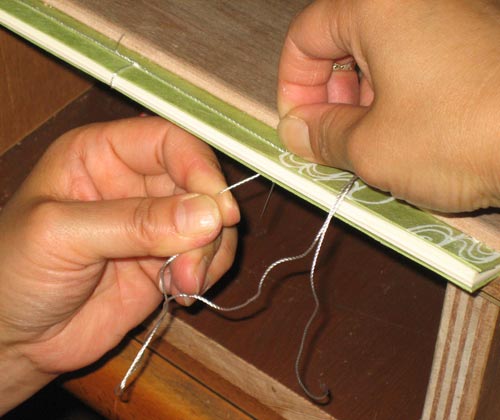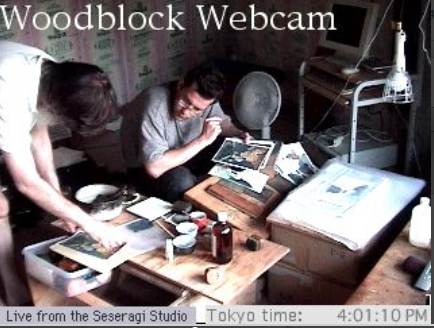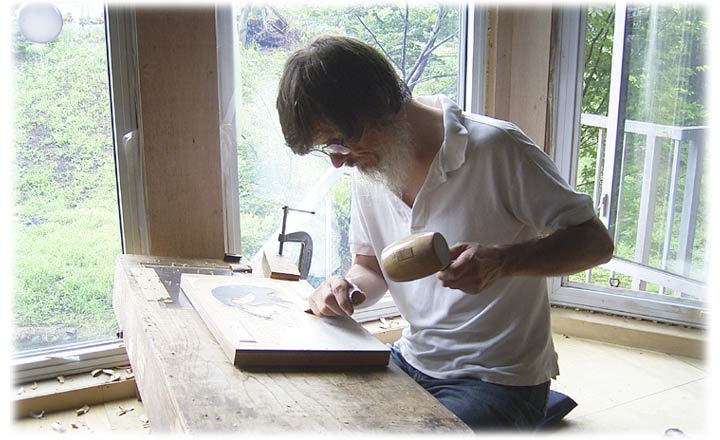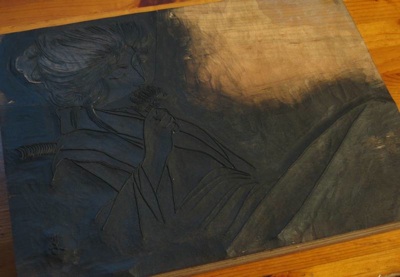Posted by Dave Bull at 9:50 PM, May 19, 2009 [Permalink]
A bit of a 'story' today ...

The River in Spring print is now all behind me. Ichikawa-san has picked up the pile of 'parts' - the signed and sealed prints, invoices, mailing labels, empty packages, etc. - and taken them back home. For the past few weeks she has been working on sewing the books ...

... and she will now put it all together and mail them out.
So for me, it's time to get started on the next one. But I don't usually jump right in the very next day; there is nearly always a backlog of miscellaneous work waiting to be done before more printmaking can begin, and so it was this time ... unanswered mail, a bit of housecleaning, even some garden work over at Sadako's place yesterday.
There was also another 'chore' to take care of (some chore!). A few days ago, a very nice order for a number of back issue sets came in from one of the collectors over in the US, and I had to get this ready for shipping. I don't keep back number sets all 'packed', but store all the parts separately (prints in drawers, etc.). Assembling them 'on demand' for each order helps ensure that the sets arrive at their destination in nice fresh condition, and not dusty from long storage on the shelves. Three of the sets in the order were easily assembled, but one - the Beauties of Four Seasons - will take longer, as I currently have none of the folders in stock, but have to cut and glue up some more.
And there is where the story comes in, because as I went to the drawer to pull out the four prints for this set, I found that after taking out the four, I have now 'hit bottom'; there are no more prints in stock for one of the prints in this set - the 20th century design for winter - and very few for the Utamaro design for summer.
So has this series been such a best-seller that they are now all gone? No. In fact, the actual situation is just the reverse; despite being the best work I have ever done (and probably will ever do), this set has never sold very well, and the reason that the drawer is now empty is because I have yet to complete the originally scheduled printing of 200 copies. I've been postponing it for years, but I guess it's now time to look in my freezer for some more copies of the Utamaro print ...

Our story begins back in the summer of 2004; the Beauties of Four Seasons series is rolling along as planned. The spring print has been completed and shipped, and the summer print is nearly done. Carving finished up a while ago, and the first batch of around 100 sheets has been finished.
But rather than start directly on the printing of the second batch of 100, I put that work aside for a time. I had something very special planned for the Autumn print - a reproduction of a Meiji era kuchi-e - and I was not completely sure that I would actually be able to carve it, at least not to the standard I felt was required.
There was also another reason for starting early. As part of my interest and research into the origins of the Meiji kuchi-e prints, I had developed a theory to explain how it was that they were created in such vast numbers. I believe that they were made using 'duplicated' keyblocks. In order to test this theory, I intended to do the same thing for my own kuchi-e reproduction - have the key block duplicated (cloned, if you will) after I completed the carving. This extra step would of course take time, so I began work on that block at this point, instead of continuing the Utamaro printing.
There were two other factors influencing the decision: I had a guest staying with me for a few weeks just then - a young man from California who wanted to sit in the workshop and 'drink in' the ambience while practicing his own carving and printing skills. I would usually not agree to such a request, but Marco was already a very accomplished printmaker in his own right, so I felt that rather than be a 'drag' on my own time and resources, his presence would instead be an interesting stimulation.

And that's pretty much how it turned out. It was good fun having him here, and I think he learned a lot too.
But. There is no question that having him here was one hell of a distraction, and my schedule suffered a bit for it. Anyway, the keyblock got done, and I sent it off for duplication.
I then got started on the colour block carving for the autumn print. As an aside, I can mention that this part of the process - which involves a whole lot of hammering with a large mallet - was kind of painful for Marco.

It's kind of like being a passenger in a car during a rough ride. The driver himself doesn't mind the tossing and bumping, because he has the wheel and 'feels' the bumps in advance. But a passenger is just at the mercy of whatever comes at him, and it is much more difficult.
So it was with Marco; my banging started to drive him crazy, and even though he tried cranking up his iPod, it just got to the point where he would go for a walk or something whenever my work required that I use the large mallet. There was no conflict between us over this; he knew that this was just 'part of the job', and that of course I had no choice but to keep working.
After I guess around a week or so, I'm not sure exactly, the colour blocks were done. The key block hadn't yet come back from the processing, so rather than waste time, I moistened some paper and got busy on the second batch of 100 sheets of the Utamaro print.
I didn't get very far. I did the jizumi (the outline block) and one colour, and then there was a delivery. The key block - and the duplicate copy - had been returned from the workshop in the US to which I had sent it. Would my theory on how these prints were made be proved by this experiment or not? Marco sat by while I eagerly opened the package, and then asked me how it was ...
Well, as they say, "I have good news. And I have bad news."
The good news was that the duplication process worked perfectly. Using a technology that was available to publishers in Meiji-era Japan, the keyblock had been duplicated perfectly - right down to a microscopic level of detail. How those prints were made in such huge quantities was now clear. A single key block was carved, and then duplicated a number of times. Multiple sets of colour blocks were then easily run up, and the sets then distributed among a number of different printing workshops. Within just a couple of weeks, it would have easily been possible to create the 10,000 copies or so that were needed for the magazine run.
But anyway, more on that stuff later, if I get time for it one day. There was also some bad news ...
The people who made the duplication for me had overdone things a little with the press that they used to take the 'casting impression'. They had really cranked it up - applying many tons of pressure. If I had been using a 'real' cherry block, the way they did in the old days, there would have been no problem. But it is almost impossible to buy good blocks these days, so we carvers 'make do' with thin laminations of cherry bonded to a plywood core.

This core - cheap 'luan' plywood - had buckled in places under the huge pressure, and the top surface of my original block (and thus that of the duplicate also) had been crushed here and there. The carved lines were all OK in basic appearance, but the top surface was nowhere near level, and the block would be impossible to print. For all intents and purposes, it had been destroyed.

Marco asked, "Well, what now?" The answer was clear; I certainly wasn't about to abandon the entire series, so the only solution was to grab another blank block, and get started on the carving again. I wrapped the Utamaro paper carefully, cleared space in my freezer, and said to it "See you later ... you take a little nap!"
I began carving.
I forgot to mention the other 'distraction' that was happening just at this time. NHK had called somewhere during this period with a request to make a short (15-minute) documentary program for their education channel, and after hearing their plans, I had agreed to have them go ahead. Sometimes, when TV crews are here, it's simple. They call up, I say yes, they show up the next day, film for a while, and we're done. This one was different; the young producer really wanted to dig into the work properly. I certainly had no complaint with this, but boy oh boy did it start to eat up a lot of time. We had days of interviews first, before any filming began, and then once the cameras arrived, they wanted to take and re-take each scene ... It was a lot of work.
And what made it worse was that the producer decided to make one of the main points of the program the part where I carved the hairlines of this kuchi-e. I can understand that, because that part was somewhat 'dramatic', but it certainly doesn't make for a relaxed carving experience. For most TV programs I use a 'demonstration block' that I keep handy just for this purpose. It doesn't matter if they keep asking me to "Just hold it there for a minute, please ... OK, now keep moving ... OK, stop please!" But this time there was no option for that, as the kuchi-e carving itself was part of the show.

They did quite a good job of making the program, but boy was I glad to see it finished. (You can view it here if you wish.)
By the time all this excitement was done, and the replacement block was ready, we were well into autumn, and there was no question of returning to the Utamaro printing. I pressed ahead with the printing work on the kuchi-e design, and finished up all 200 copies. And then once that was done, I moved ahead with work on the winter print ... Marco too, returned to the US, and things got back to 'normal' ...
Move ahead a few weeks, and by the time the preparation, carving, proofing, etc. had been done on the winter print, I was again getting pressed for time. The problem now was the preparation for the next series. I had already decided to create the Hanga Treasure Chest, but this needed a huge amount of preparatory work. I spent a lot of time designing the concept, and especially the case. (Sadako and I actually flew down to Hong Kong to find a company who could build these for us.) And I had to get the first print in the set ready and finished in time for the exhibition coming up in early January.
So what with one thing and another, the second batch of 100 copies of the winter print in the 'Beauties' series just never got scheduled. Work on the Treasure Chest - a new print prepared, carved, printed (200 copies!), and shipped every two weeks right through the year - just ate my life completely. That was then followed by the scroll project ... and then the My Solitudes project ...
So here we are. After shipping this week's order, my drawer is now empty. So this afternoon I 'took stock' of the situation. First step was to retrieve the Utamaro prints from their long sleep (nearly five years!) in the freezer.
How are they? Perfect! As I sit here writing this, they have thawed out completely, and I have re-stacked them between sheets of slightly dampened newsprint so that they can 'level out' their moisture. They are wonderfully soft and supple, just perfect for printing!
But thinking about the situation carefully, I don't think that I can take on that work just now. If I get involved in those two reprints - which would involve weeks and weeks of work - I would fall just too far behind in the current series. So I'll dry these sheets off this evening, and file them carefully in their drawer to wait their turn.
I'm thinking that the best time to tackle this job will be when the Solitudes series is just wrapping up, early next year. Doing the reprints of these two reproduction type prints then would be a good break for me, before I get started on whatever it is that I will be doing for the next project ...
But if you had told me back in the summer of 2004, that it would be nearly five years before those prints would come out of their long deep (and very cold!) nap, I would have thought you were crazy!
